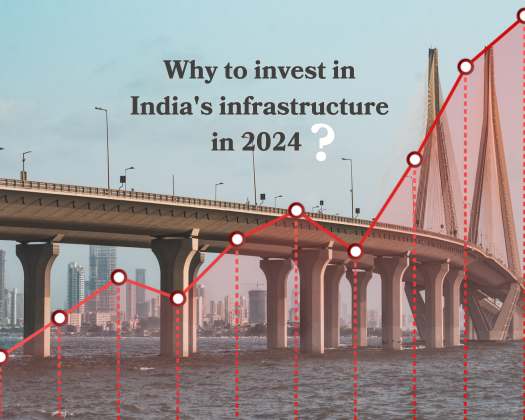India's Infrastructure Revolution: A Compelling Investment Opportunity in 2024 and Beyond
Introduction:
In a paradigm-shifting revelation, CRISIL, during its flagship India Infrastructure Conclave 2023, projected that India is set to witness a monumental surge in infrastructure spending, reaching nearly Rs 143 lakh crore over the next seven fiscal years until 2030. This colossal investment, more than twice the amount spent in the previous seven fiscal years, underscores the country's commitment to robust development across sectors. Here, we delve into the reasons why investing in India's infrastructure in 2024 presents a compelling opportunity for both domestic and international investors.
Unprecedented Growth Projections:
CRISIL forecasts India's gross domestic product (GDP) to grow at an average of 6.7% through fiscal 2031, positioning the nation as the fastest-expanding large economy globally.
Per capita income is expected to rise from ~$2,500 to ~$4,500 by fiscal 2031, marking a significant increase and establishing India as a middle-income country.
Focus on Sustainability:
A notable shift in this infrastructure wave is the emphasis on sustainability. Approximately Rs 36.6 lakh crore, a fivefold increase compared to the previous fiscal years, is earmarked for green investments.
This marks a pivotal move towards integrating sustainability into the fabric of infrastructure development, aligning with global environmental goals.
Thoughtful Policy Interventions:
The CRISIL Infrastructure Yearbook 2023 introduces the CRISIL InfraInvex, a unique national index measuring the 'investment attractiveness' of select infrastructure sectors. This year, environmental sustainability is incorporated into the index framework, reflecting its growing significance in investment decisions.
Policy interventions and a conducive investment climate have contributed to positive trends in infrastructure scores, particularly in sectors such as roads, highways, power transmission, renewable energy, and ports.
Diversification of Projects:
The next phase of infrastructure development is expected to witness a growth in the average ticket size of projects, indicating a shift towards mega-scale projects.
With consistent policy and regulatory interventions, stakeholders can capitalize on this diversification, making the infrastructure investment landscape attractive for various contributors.
Emerging Sectors and Technologies:
Emerging sectors such as electric vehicles (EVs), renewable energy, battery storage, and hydrogen are poised to play a pivotal role in shaping India's sustainable infrastructure.
The share of EVs in India's automobile sales is projected to reach ~30% by 2030, with two-wheeler EV sales leading the way. Similarly, the hydrogen sector is expected to attract substantial investments, estimated at ~Rs 1.5 lakh crore between fiscals 2024 and 2030.
Bond Market Acceleration:
Meeting the massive funding needs of these projects requires accelerated bond market activity, increased foreign investment interest, and robust equity markets.
India's first sovereign green bond issuance is anticipated to set the stage for domestic bond market development for green issuances, tapping into the global appetite for green assets.
Monetization Opportunities:
The pace of monetization, evolving asset monetization models, and support for sustainable urban infrastructure are crucial elements for timely fund flows and providing exits to existing investors.
Regulatory Evolution and Clarity:
Regulatory evolution and clarity in areas such as carbon market development, grid integration of renewable energy, Production Linked Incentive scheme for the EV value chain, and energy storage will further boost investor confidence.
Conclusion:
As India propels itself into a new era of infrastructure development, characterized by sustainability, growth projections, and diversified projects, the investment landscape appears highly promising. Both domestic and international investors stand to benefit from this unprecedented surge, contributing to the nation's evolution as a global economic powerhouse. The confluence of thoughtful policy interventions, sustainable practices, and emerging technologies makes investing in India's infrastructure in 2024 an irresistible opportunity for those seeking long-term returns and impact.









